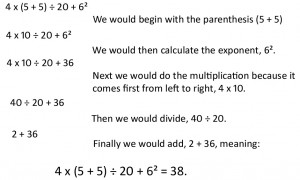Topics:
- Place Value
- Exponents
- Order of Operations
Place Value
Place Value has a lot to do with knowing what the specific digits of a number mean. In sixth grade, we deal with place value up to the trillions. This includes everything from the ones column all the way up to the hundred-trillions column. Below is a picture which shows all of the places we will be dealing with: (Remember, you can click images to enlarge them)
There are two vocabulary words we need to become familiar with. Place which is the column the number lives in. Ex. The 5 in the above number is in the hundred trillions place. Value is how much each individual digit is worth. The 5 in the hundred trillions place is only a 5, but in actuality, it is worth five hundred trillion (500,000,000,000,000)
There are also four different ways we are going to work with writing numbers.
Standard Form is typically the first thing you think of when you think of a number. Whether it be 1, 47, or 577,800,000,000,000 as is pictured above. All of those are standard forms of numbers.
Word Form is what you say when you read a number. Using the same examples as with standard form they would be one, forty-seven, five hundred seventy-seven trillion, eight hundred billion.
Short-word- Form mixes words and numbers by breaking the groups of three apart. It is used most often with longer numbers such as 577 trillion, 800 billion.
Expanded Form breaks each place into it’s specific value and shows them adding together one by one. 47 = 40 + 7, or 577,800,000,000,000 = 500,000,000,000,000+70,000,000,000,000+7,000,000,000,000+800,000,000,000.
The one thing left to make note of is when you have a 0 in a place. Let’s say I have the number 2,003. Because zero times anything equals zero, (0 x 100 = 0, and 0 x 10 = 0), I only have to write out the place values for non-zero numbers. 2,003 would be written 2,000 + 3.
Exponents
When dealing with exponents there are two specific numbers we need to be aware of. Each exponent has a base number and the exponent. Let’s take the exponent 3⁵ (said ‘three to the fifth power’). The base number is the 3 and the exponent is the 5.
Now, exponents are considered to be repeated multiplication where you multiply the same number by itself.. The base number tells you which number to multiply, and the exponent tells you how many times to multiply it. so if we take the same 3⁵, it will be the 3 that we multiply by itself (3×3, etc.) The five tells us to multiply it 5 times. There are three different ways we can represent this.
Exponent Form: 3⁵
Product Form: 3 x 3 x 3 x 3 x 3
Standard Form: 243
There are also different ways we can say certain exponents. Specifically, a number to the second power (ex. 4²), which could be said four squared. The reasoning behind this comes later when we begin our geometry unit. To find the area of a square, you times the side by itself. The other exponent that has a special name is any number to the third power (ex. 4³), which would be said four cubed. Again, the basis for this comes from geometry. When we find the volume of a cube, we times the side by itself 3 times.
The final idea within this lesson is another form for writing numbers. It incorporates both expanded form and exponents. It is used a lot in science when we discuss distances in space that are far more miles than we’d want to completely write out every time. I will use a smaller number for an example:
Let’s take the number 4,512. Broken into expanded form it would be 4,000+500+10+2. We know that 4000 would be equal to 4 x 1,000, so we could break that entire number apart so it looks like the following:
(4 x 1,000) + (5 x 100) + (1 x 10) + (2)
Now, one thing we need to make clear is that any number to the zero power is one. So if I were ask you to evaluate 10⁰, it would equal 1. We also need to be familiar with our powers of 10. For this example, we only need up to 10³, but for even larger numbers the idea remains the same. 10³=10x10x10=1,000. 10²=10×10=100. 101 = 10. 100=1. With that in mind, our expanded number above could be written as follows:
(4 x 10³) + (3 x 10²) + (1 x 101) + (2 x 100)
You can see how this would come in handy when dealing with such numbers as given in the example for Place Value. Rather than having to write out all of those zeroes, you could simply write:
(5 x 1014) + (7 x 1013) + (7 x 1012) + (8 x 1011)
Order of Operations
There are many different ways to remember the order of operations. One is simply the mnemonic PEMDAS. Parenthesis, Exponents, Multiplication, Division, Adiition, and Subtration. You could also use fun little phrases like Please Excuse My Dear Aunt Sally. Remembering the order is important, but we also need to remember that multiplication and division are on the same level, as well as addition and subtraction. This means we do them at the same time from left to right. This will make a difference in some expressions.
Click this link to view a PEMDAS Music Video made by one of my previous years’ students.
Here is a step by step example showing proper use of order of operations:


